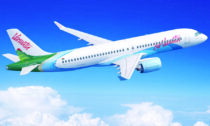The VanuatuSolar Tax
March 12, 2024 11:58 pm | Posted in Features | Share now TwitterFacebook

The National Energy Roadmap of Vanuatu was launched in 2013 by the Vanuatu Government
The overall vision of the 2013 version of the National Energy Road Map (NERM) was to energize Vanuatu’s growth and development through the provision of secure, affordable, widely accessible, high-quality, clean energy services for an educated, healthy, and wealthy nation. Vanuatu’s NERM was first endorsed by the Council of Ministers in 2013. At that time, the NERM identified five priorities for the energy sector: access, petroleum supply, affordability, energy security, and climate change. The roadmap was updated in 2016.
Electricity Supply Grids in Vanuatu
There are two main concessions in Vanuatu. In Santo, it is operated by Vanuatu Utilities and Infrastructure (VUI) and on Efate, it is held by UNELCO. The electricity rates are set by the Vanuatu Utilities Regulatory Authority (URA), a government body that regulates the Utilities market in the country. Rates a set based on regular consultation between the URA and the concession holders and are based upon fluctuations on costs. Based on these costs the rates are adjusted accordingly. One of the terms of the concession agreements is that rates are set on different tiers based upon usage. In very simple terms, large user pay
more for their electricity than small users. This creates a situation where larger users are subsidizing low consumption users making it much more affordable for low income households. In March 2024, the UNELCO rate paid by Low Voltage user up to 60kwh was VT22.56 per KWH.
The graph below shows that electricity rates for small users is one of the lowest in the Pacific whereas for large consumers, it
is the third highest.

Rooftop Solar in Vanuatu
With the support of the Vanuatu govt and the lower capital investment costs to setup solar power it became increasingly attractive for Rooftop Solar systems to be installed in Vanuatu. Energy from the sun is free, but there are upfront capital investments that need to be taken in to consideration when assessing the economics of Solar. After factoring in depreciation and capital costs for Solar installations, it is currently much cheaper to have solar power than to use power from the grid.
There are two main types of Rooftop Solar power systems that can be installed. Stand Alone Off-Grid systems and Grid Connect systems. All solar Panel Systems generate power from the sun. The main difference is that Off Grid Solar Systems are not connected to the UNELCO/VUI power grid. Instead, they
allow owners to generate and store their power through the installation of Batteries. The main advantage of an Off-Grid system is that power can be stored in batteries to be used at a later time when the sun is not shining. The falling prices and increased reliability of Lithium Ion battery systems have made this option more and more attractive.
Grid Connect systems are systems that are connected to the electricity Grid. When there is excess demand for power, electricity is drawn from the grid to cover the shortfall. However, there are limitations as this system is best when installed in buildings that use the most power when the sun is shining and is therefore more suitable for commercial applications when the demand for power is aligned with power generation. When there is excess power generated from the system, there is the option for this to be fed back into the grid. In Vanuatu, grid connect systems have been installed without the possibility of
feeding power back to the Grid.
Because of the high rates charged for large consumers, the incentive to install solar and reduce these costs is nearly all coming from those who are large users of power. This is a natural response to the economics of the energy market. The problem with this is that as more and more, large businesses and households install grid connect systems, it reduces the amount of demand for electricity from those who are subsidizing the low consumption connections. When this happens, the Utilities experience little growth and revenues are affected creating upward pressures on the rates for low
consumption users.
From the side of a consumer, the power system serves one purpose: to deliver electricity to homes and businesses so that it powers our daily operations. But from a generator and a system operator perspective, there is much more at play.
When there are more and more solar connections on the grid, the Providers and Managers of the grid are required to spend more time balancing the power on the system. What does it mean for the electricity network to be balanced? Balancing the power system is about ensuring electricity supply meets demand second by second. If demand exceeds supply, or vice versa, this creates instability in the grid. Demand from Solar installations will fluctuate in accordance with sunshine. When there is a lot of sun, demand drops off so the operators of the grid will need to reduce the supply of power. When there are
periods of very little sun, energy demand increases because those who have large power needs and have large solar installations will draw power from the grid.
Electricity must be transported the length of the concession, levels of generation must be managed so they are exactly equal to levels being used, and properties like voltage and frequency must be constantly regulated across the whole network to ensure power generated at the power stations can be used by domestic appliances plugged into wall sockets. All this comes at a cost and this cost does not change irrespective of the total amount of power consumed.
According to UNELCO, 60% of its operating costs are fixed operating costs. 32% of these costs cover fuel with an additional 8% profit component. This means that 60% of the costs of UNELCOs costs are fixed.
UNELCO’s cost structure is shown on the following diagram.

The Solar “Tax”
On the 8 March 2024, in the official government Gazette No 13, the URA announced that a Solar Connection charge of VT45.26 would be levied for clients of VUI who has installed Grid Connect Systems. This charge would be levied on top of any fixed charge and power drawn from the Grid. It is not very clear whether this charge would be based upon the amount of power generated by the Solar System, or the amount of power consumed but the wording in the document has said VT45.26/ Kwh Consumption.
Any solar panel installations with a grid connection in Santo have three months to register with VUI and to comply with their requirements. The Implementation of the solar connection charge on Efate with UNELCO has still not been tabled but there has been discussions on this.
The rate which has been gazetted is VT45.26/KwH. This rate is based on the percentage of the fixed operating costs of VUI as determined by the URA multiplied by the agreed base rate. In the case of VUI, the base price of electricity is VT60.75 with the fixed costs portion of 74.5%. This is calculated at 74.5% of VT60.75 = VT45.26.
What is the rationale behind the Solar Connection Charge?

Under the terms of the concession and rates set by the URA, high voltage user and businesses have been subsidizing small domestic low voltage users. In Santo approximately 21% of power demand comes from small domestic users. Small domestic users on rate 1 are those who consume less 60kwh per month. Based on the amounts in the table above, there are in excess of 3,200 connections that use up to 60kwh per month.
Because of the much higher rates charged for high voltage users, solar installations have become increasing popular due to the lower costs of generating power and the amount of installations have increased. As a backup to their solar installations, many users have elected to remain connected to the grid so that they can use Grid power when the Sun isn’t shining. With an off grid system, there is much higher capital investment because batteries are required to store backup power. In addition to this, the power generation levels of an off grid system needs to be much higher to ensure that batteries
are kept fully charged.
The argument for the Solar Connection charge is that for those who wish to remain connected to the grid as a backup, they have to pay for their share of maintaining it and in the case of VUI, 74.5% of their operating costs.
Is this New Policy going to work??
Governments around the world pass legislation and fiscal budgets regulating their domestic economies. These include levels of taxation, tax incentives and allocation of resources in their fiscal budgets. In Vanuatu, the government has subsidized copra prices when they fall too low and have offered tax relief during times of natural disasters. The new Solar Connection charge is a good example of an attempt by the URA, the regulatory arm of the government, to manipulate the energy market. In Australia, the government has offered tax credits for solar installations as part of their commitment to achieve
a renewable energy target of 82% of electricity generation by 2023. In Vanuatu, it seems that despite initial announcement by the Government supporting and promoting the use of solar, the reverse is happening.
With the solar connection charge, those who are currently enjoying savings on Grid connected solar will now have to pay an additional charge to the Utility in addition to the power that they have drawn from the grid. When factoring in the capital investment of Solar, this has removed completely any financial incentives to invest in Grid Connect, leaving Off Grid systems as the only option. The immediate effect of this has been the cancellation of many installations that have been in the planning stage due to the uncertainty on how this will play out.
There is no doubt that this new regulation will dramatically affect the businesses that are currently offering solar. The investment in off grid system will be much higher than those of Grid Connect and due to the high cost, only a limited number of individuals and businesses will be able to afford the investment.
There are many questions that need answers.
There is the question of whether the government will compensate those who have already made significant investments in Solar and now find themselves having to pay higher costs to remain connected to the Grid. What is the definition of Grid Connect?? Many businesses have separate meters for different departments within their organization. If an off grid solar system is installed alongside a normal meter, is this still considered Off Grid?? If the URA proceeds to enforce the new charge, the effect of this will be to reduce the use of solar in the country for the sake of supporting the rate subsidy. Are there any other options available that can be implemented to achieve the same objective.
Whats Next??
Will our Sun Tax, go the same way as the controversial one that was implemented in Spain in 2015 and abolished in 2018 after 3 years of protests and criticism. The main objective of the Spanish “Sun Tax” was to address the potential effects of self-consumption of solar energy on the stability and financial viability of the national electricity grid. Sounds familiar?? It eventually abolished when the Spanish Government decided that it did not align with its objective of a more favourable and enabling environment for the expansion of solar and other forms of clean and sustainable energy.
Paradoxically, this week, Vanuatu, through its Climate Diplomacy Program finally submitted its written submision to the ICJ leading a global coalition to adopt a UN General Assembly Resolution asking the International Court of Justice (ICJ) to clarify State obligations and legal consequences related to climate change and how existing international Laws can be applied to strengthen action on climate change, protect people and the environment and save the Paris Agreement.










